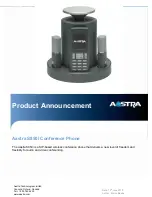
Chapter 7-Entry Queues, Ad Hoc Conferences and SIP Factories
Polycom, Inc.
7-17
When SIP registration is not enabled in the conference profile, the RMX's registering to
SIP Servers will each register with an URL derived from its own signaling address. This
unique URL replaces the non-unique URL, dummy_tester, used in previous versions.
•
Failed
-
Registration
with the
SIP
Server
failed.
This may be due to incorrect definition of the
SIP
server in the
IP Network Service
, or the
SIP
Server
may be down, or any other reason the affects the connection between the
RMX or the
SIP Server
to the network.
•
Registered
- the conferencing entity is registered with the
SIP Server
.
•
Partially Registered
- This status is available only in
Multiple Networks
configuration,
when the conferencing entity failed to register to all the required
Network Services
if
more than one
Network Service
was selected for
Registration
.
Ad Hoc Conferencing
The Entry Queue can also be used for Ad Hoc conferencing. If the Ad Hoc option is enabled
for the Entry Queue, when the participant enters the target conference ID the system checks
whether a conference with that ID is already running on the MCU. If not, the system
automatically creates a new ongoing conference with that ID. The conference parameters are
based on the Profile linked to the Entry Queue. As opposed to Meeting Rooms, that are
predefined conferences saved on the MCU, Ad Hoc conferences are not stored on the MCU.
Once an Ad Hoc conference is started it becomes an ongoing conference, and it is monitored
and controlled as any standard ongoing conference.
An external database application can be used for authentication with Ad Hoc conferences.
The authentication can be done at the Entry Queue level and at the conference level. At the
Entry Queue level, the MCU queries the external database server whether the participant
has the right to create a new conference. At the conference level the MCU verifies whether
the participant can join the conference and if the participant is the conference chairperson.
The external database can populate certain conference parameters.
For more information about Ad Hoc conferencing, see
Appendix D,
"
Ad Hoc Conferencing and
External Database Authentication”
on page
1-1
.
Gateway to Polycom® Distributed Media Application™ (DMA™) 7000
Gateway to Polycom® Distributed Media Application™ (DMA™) 7000 enables audio only
PSTN, ISDN (video endpoints using only their audio channels), SIP and H.323 calls to
connect to the Polycom DMA 7000 via gateway sessions running on the RMX. Each RMX
conference acting as a gateway session includes one connection to the endpoint and another
connection to the DMA. The DMA 7000 enables load balancing and the distribution of
multipoint calls on up to 10 Polycom RMX media servers.
As part of this solution, the RMX acts as a gateway for the DMA that supports H.323 calls.
The PSTN, ISDN or SIP endpoint dials the virtual Meeting Room on the DMA via a special
Entry Queue on the RMX.
For more information, see
"
Dialing to Polycom® DMA™ 7000”
on page
19-25
.
Summary of Contents for RealPresence 2000
Page 26: ...RealPresence Collaboration Server RMX 1500 2000 4000 Administrator s Guide xxiv Polycom Inc...
Page 842: ...RealPresence Collaboration Server RMX 1500 2000 4000 Administrator s Guide 23 60 Polycom Inc...
Page 962: ...RealPresence Collaboration Server RMX 1500 2000 4000 Administrator s Guide E 4 Polycom Inc...
Page 968: ...RealPresence Collaboration Server RMX 1500 2000 4000 Administrator s Guide F 6 Polycom Inc...
Page 1128: ...RealPresence Collaboration Server RMX 1500 2000 4000 Administrator s Guide J 18 Polycom Inc...
















































